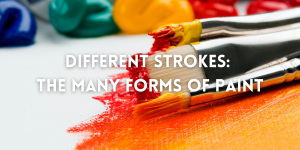Mar 14, 2022

Paint is such a complementary tool in the realm of home construction. The variety of color palettes gives each room a bursting of life and a reflection of one’s individuality. But, paint is more than just an aesthetic tool. In fact, did you know that different types exist, each made for specific purposes and with contrasting advantages in mind?
For today’s blog article, let us look at how each kind of paint differs from others, where best to use them, and how to apply them properly.
This type of paint, also commonly known as acrylic latex, is known best for its waterproof qualities, thanks to its high density. Once it dries, it forms a thick and flexible coating that makes it heavily resistant to moisture. Hence, most painters widely prefer utilizing this paint on the exteriors of homes and structures, especially on corrosive metals and porous concrete. In addition, the colors do not quickly fade over time, and the paint can dry fast with little to no odors.
Firstly, ensure that the weather conditions are not too warm or cold. Stir the paint to reach the right consistency and remove any bubbles. Begin with a damp paint roller and cover the area. After drying, add more coating layers, depending on the manufacturer’s instructions on the bucket.
Not only is a well-colored room a pretty sight to behold. It is also a visual sign of the room’s cleanliness (at least when it stays dry). When a wall gets wet stains, the moisture will encourage the growth of bacteria and molds, which may harm the immunocompromised and the allergic.
Fortunately, anti-microbacterial paint formulas exist, with their composition capable of inhibiting the cultivation of microbes. Other brands such as Davies Bio-fresh+ paints possess an anti-stain quality that prevents hard-to-remove liquids such as coffee, inks, and juices from penetrating the coating, making spills easy to clean.
Instructions for application are attached to the bucket, but, in summary, you must use a layer of concrete primer & sealer before painting a layer of the anti-bacterial coat.
There are benefits to having your roof painted, especially in lighter shades. Besides adding to your home’s overall appeal, roofing is a cost-effective alternative to heat insulation and cooling, particularly in warm climates.
Thus, maintaining and protecting it from harsh elements is essential. Gloss paint such as that of BOYSEN® Roofgard™ performs well for almost all roof types, from galvanized iron to shingles to ceramic tiles. Additionally, it is highly durable and resistant to weathering.
With that said, applying the paint may differ from the material of your roof. For galvanized iron roofs, surfaces should be smoothened and free of rust. Rub it with sandpaper before applying a layer of the paint.
The chlorinated rubber type is beloved by many painters because of its versatility. You can utilize this paint on almost any surface, but use is most common on exteriors or outdoor places due to its impressive durability and quick-dry qualities. Prime examples include the floors of basketball courts and other sports venues. Brands that provide this include Davies with its Acreex Chlorinated Rubber Solvent Based Floor Coating.
Another advantage this type possesses is its easy-to-use applications. After cleaning the surface area, put at least one or two coatings and let it dry for a few hours (or a few days for more spacious places). However, note that chlorinated rubber has a pungent odor compared to other paints, so wear a mask to shield yourself from the smell.
Steel gates and metal window frames also need a fresh and glossy coat of paint that works well as a beautifier and an effective shield from rust. All the more reason to grab a bucket of epoxy primer that can fulfill these two roles. Besides covering corroded spots and protecting the steel from damaging natural elements, this paint also fixes dents and cracks thanks to its excellent bonding quality.
Before application, know that epoxy primers such as Davies Coat Saver® Epoxy Primer with Hardener work best on ferrous (iron) metals; non-ferrous metals require Coat Saver® Galvan-Zinc Epoxy instead. After cleaning the surface area, apply the first layer with the primer and finish it with epoxy enamel. Let it dry for four hours or overnight.
And, there you have it! Familiarize yourself with the various paints you can use to make your house spick and span.
If you are interested in looking more beyond those recommended on this article, visit any All Home branches in Metro Manila and nationwide. We offer DIY, Hardware, Construction Materials, Flooring, Furniture and Appliances, Homewares, Linens, Sanitary Ware, and more!
You may also visit our website and enjoy the hassle-free experience of shopping online through AllHome.com.ph today!
AllHome online store has a shopping site that offers fast delivery, cash on delivery, and easy payment terms. You may also follow us on our official Facebook and Instagram accounts for more updates.
Customer Service Hotline: +63 968-2434-789